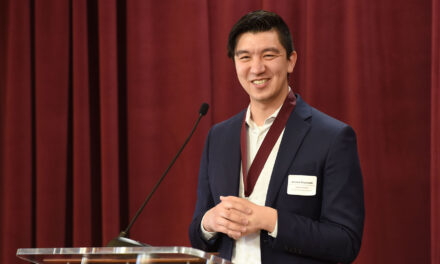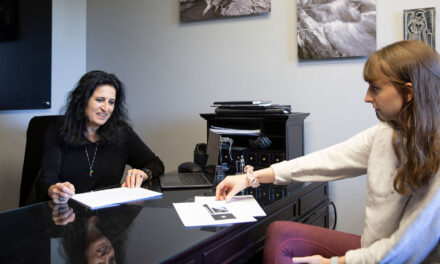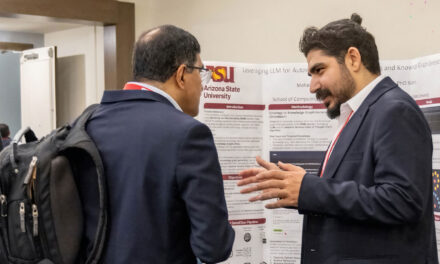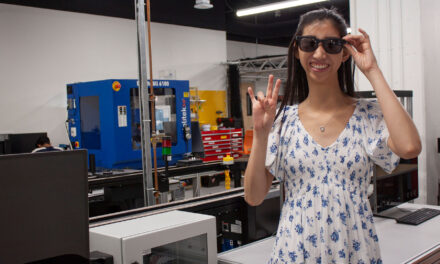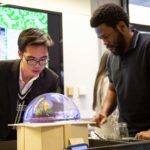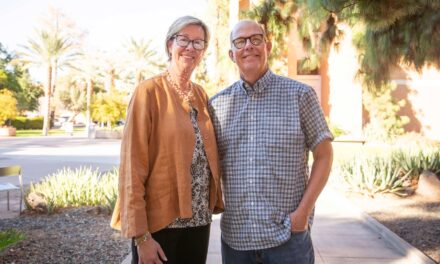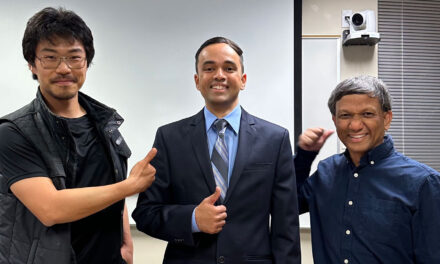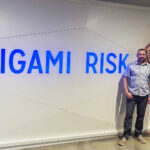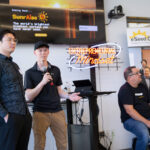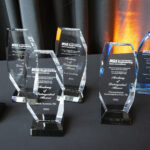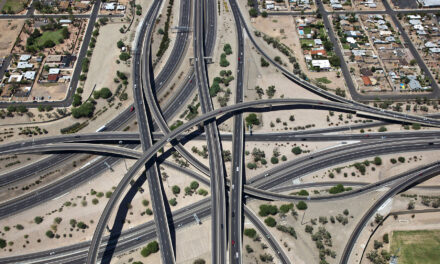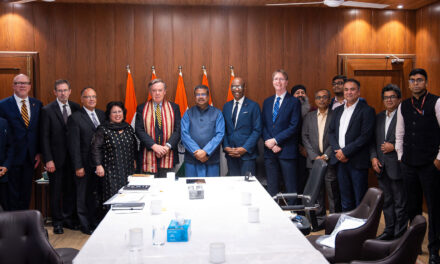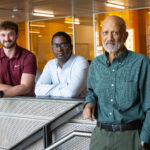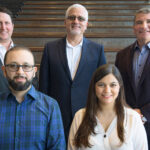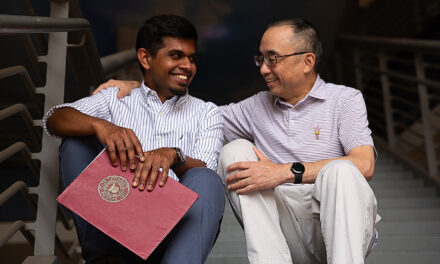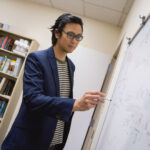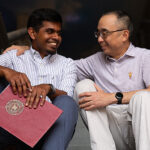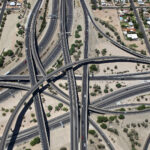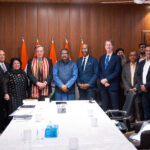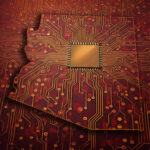
Q&A with Shawn Jordan: Building epic machines, winning prestigious awards

Shawn Jordan, center, assistant professor of engineering education in the Ira A. Fulton Schools of Engineering, in the STEAM labs with students. Photographer: Jessica Hochreiter/ASU.
Shawn Jordan, an assistant professor at the Polytechnic School, one of the Ira A. Fulton Schools of Engineering at Arizona State University, was recently selected for a Faculty Early Career Development (CAREER) award, one of the most prestigious awards given by the National Science Foundation. Recipients are junior faculty who exemplify the role of teacher-scholars through outstanding research and excellence in education and show the promise of a lifetime of leadership in integrating education and research.
Jordan studies context in design, informal engineering education, Makers, and cross-disciplinarity. Over the past six years, he has co-developed the STEAM Labs™ program, which challenges middle- and high-school student teams to apply the engineering design process to build chain-reaction machines like those made famous by cartoonists Rube Goldberg and Heath Robinson. It teaches engineering skills, systems thinking and collaboration, and integrates the arts with the STEM fields of science, technology, engineering and math. Jordan also led two teams to collegiate National Rube Goldberg Machine Contest championships.
Jordan held the Guinness World Record for the largest number of steps – 125 – in a working Rube Goldberg machine and one of his Rube Goldberg machines was featured in a movie. He has appeared on many TV shows, including “Modern Marvels” on The History Channel and “Jimmy Kimmel Live” on ABC. He worked as a behind-the scenes engineer for season three of the PBS engineering design reality TV show, “Design Squad.”
Jordan’s CAREER award supports his work bringing STEAM Labs™ camps to the Navajo Nation. Jordan also is using data from the camps to help develop curriculum for Navajo Nation middle schools, which will be required to include engineering design in science classes beginning in the fall of 2015 as part of the Next Generation Science Standards for K-12. It is a continuation of work started on the Navajo Nation under a Woodside Sustained Community Service Award in 2012.
Question: How will the CAREER Award help promote your research?
Answer: I want to promote the development and use of culturally contextualized curriculum to help students connect engineering to their everyday lives. My CAREER award will provide an engineering design curriculum for Navajo middle schools that will help illuminate engineering as a viable career pathway. In addition, the research methodology that I have developed is generalizable, meaning that it can be replicated to create culturally contextualized curriculum for other cultures and societies.
Q: How did you get interested in Rube Goldberg machine competitions?
A: In high school, I saw a documentary on the Discovery Channel about the Rube Goldberg Machine Contest and was fascinated by the whimsical complexity that was present in the designs. As someone who is highly multidisciplinary, designing Rube Goldberg machines provided me a canvas on which I could bridge engineering and art.
Q: What was the craziest thing that happened to you in a competition?
A: In one machine, we needed to transport aluminum cans across the machine to a can crusher. We tried multiple ideas over six weeks leading up to the competition, but the cans kept getting stuck before reaching the crusher. One of my teammates saw a program on the history of logging on the History Channel, which inspired us to build a can flume (basically a waterslide) on the machine. It worked perfectly, except that we did not have time to design a place for the water to go at the bottom of the flume. On the day of the contest, one of my teammates wedged a bucket at the end of the flume to collect the water. When the judges came by to watch the machine, enough water had collected in the bucket that the center of gravity changed, causing it to tumble off the machine and soak a judge from the waist down. He did not visibly react, but needless to say we did not win that competition.
Q: What did Jimmy Kimmel say about the machine?
A: Jimmy Kimmel was impressed with the ingenuity that went into the useless machines, and the junk that went into their construction (much of which came from dumpster diving). He also questioned how effective the machines were at “driving the ladies wild.” Both he and Charlie Sheen expressed concern over the safety of the machine, particularly when it came to reaching inside to press the start button.
Q: How do the machines and camps get young students interested in engineering?
A: Rube Goldberg machines engage students on multiple levels to design both the problems they want to solve and the solutions for those problems (similar to the maker movement). This is different than many of the standard engineering outreach activities, which give students a specific problem to solve. This environment creates an opportunity for creativity, imagination, and making dreams of inventions a reality. It challenges students to not only ask “Why?” but also “Why not?” a question that I think is all too often lost in today’s youth. This, in turn, helps students understand that you can be creative and be successful at engineering – an important message given pop culture’s less-than-flattering messages about engineering.
Q: What is the most important thing you already have learned though your research?
A: That making in engineering helps students learn concepts more deeply. Traditional K-12 education uses textbooks to teach concepts, leaving students to make connections between the classroom and their everyday lives. In my interviews of students participating in STEAM Camps™ on the Navajo Nation, students told stories of the making and building they did regularly at home (e.g., helping wire solar panels or fix machinery) and how they now understood the theory behind what they made as a result of the camp. This reinforces the need for more project-based learning in schools.
Q: What would your dream research project be?
A: A project that makes a significant impact on society. I believe there is immense value to making and project-based learning in creating a society that I would want to live in – one where people feel empowered to design and build the change that they want to see. However, our formal education system is primarily focused on the standardized testing of memorized facts and critical thinking, which is only a part of what students need to learn in order to be successful. It is difficult to measure what students learn from informal engineering education experiences, which is hampering more widespread adoption of these powerful pedagogical strategies. I would love to do research to bridge this chasm and allow project-based learning to be fully embraced in formal education.
Q: What’s the wildest engineering adventure you’ve had?
A: In graduate school, ABC asked me to design and build a large-scale Rube Goldberg machine for a show called “Master of Champions.” Most of my top Rube Goldberg teammates had graduated and moved around the country, so I assembled them in a virtual team, where we collaborated over the Internet instead of in-person, and we proceeded to design and build an entire machine over the Internet in several weeks. We ordered all of the parts, had them shipped to Los Angeles, and built the entire machine from scratch – in 36 hours. This wild build was a lot of fun and helped me appreciate design where money is plentiful and time is limited, but also inspired my doctoral dissertation work to study what makes virtual teams in industry successful.
Q: What’s the most exotic place you have done engineering?
A: In college, I worked as a behind-the-scenes engineer for the PBS engineering design reality TV show “Design Squad.” Every day of work was filled with fun challenges, like “How do we rent an entire lake?” and “We need 100 bicycles to use in building bicycle-powered hog rotisseries.” One of the most interesting challenges was for the season-three finale, where the cast spent a week building sailboats from scratch on an island off the Marblehead area of Massachusetts. The behind-the-scenes team was challenged with packing and moving our workshop and supplies onto a barge, shipping it to the island, reassembling the workshop on the beach, and building and testing sailboats. It was the most scenic work environment I’ve had in my life, although the gardens at the Polytechnic campus are quite beautiful.
Q: Did you love the Breakfast Machine in Pee Wee’s Big Adventure?
A: Yes, it is epic. I once started building a food-making machine out of food, but ended up eating the pieces before it was complete.
Q: Do you have pets, and do you deliver their meals by machine?
A: I don’t have pets yet, but I do have a small army of home automation robots that water the houseplants, clean the floors, and optimize the energy used by the house based on my schedule. I am also getting ready to install an Internet-controlled sprinkler system that adjusts watering based on the weather. I plan to continue supporting smart and Internet-controlled technology that does housework so that I have time to get a pet.
Media Contact:
Judy Nichols, [email protected]
(480) 965-9248
Ira A. Fulton Schools of Engineering


